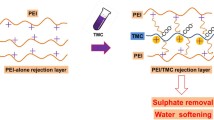Abstract
A type of poly(arylene ether sulfone) with pendant tertiary amine groups (PSDA) was synthesized via nucleophilic substitution polymerization of 3,3′-dimethylaminemethylene-4,4′-oxybisphenol (DABP) and 4,4′-bisfluorodiphenyl sulfone(BFDPS). The resulting polymer was used to prepare a nanofiltration membrane via a convenient one-step phase inversion process. The preparation conditions were investigated; the optimum parameters were 30 wt% PSDA, 30 wt% THF, 40 wt% DMF casting solution, and 10 s evaporation time. The zeta potential test indicated that the PSDA membranes were positively charged below pH 11.0. The results of the membrane performance testing showed that the trend for rejection was RFeCl3 > RMgCl2 ≈ RCaCl2 > RNaCl > RNa2SO4 (R=rejection), which was a typical positively charged nanofiltration membrane performance. The PSDA membrane also showed excellent chlorine tolerance; no obvious performance change was observed after exposure to an aqueous NaOCl solution (active chlorine concentration no less than 1000 ppm) for 15 days.









Similar content being viewed by others
References
Sutherland K (2008) Filtr Sep 45 (32)
Schaep J, Van der Bruggen B, Uytterhoeven S et al (1998) Removal of hardness from groundwater by nanofilitration. Desalination 119(1–3):295–301
Riera-Torres M, Gutiérrez-Bouzán C, Crespi M (2010) Combination of coagulation flocculation and nanofiltration techniques for dye removal and water reuse in textile effluents. Desalination 252(1–3):53–59
Tepus B, Simonic M, Petrinic I (2009) Comparison between nitrate and pesticide removal from ground water using adsorbents and NF and RO membranes. J Hazard Mater 170(2–3):1210–1217
Yangali-Quintanilla V, Maeng S, Fujioka T, Kennedy M, Amy G (2010) Proposing nanofiltration as acceptable barrier for organic contaminants in water reuse. J Membr Sci 362(1–2):334–345
Geens J, De Witte B, Van der Bruggen B (2007) Removal of API’s (active pharmaceutical ingredients) from organic solvents by nanofiltration. Sep Sci Technol 42(11):2435–2449
Mohamm A, Othaman R, Hilal N (2004) Potential use of nanofiltration membranes in treatment of industrial wastewater from Ni–P electroless plating. Desalination 168(1):241–252
Vandezande P, Gevers L, Vankelecom I (2008) Solvent resistant nanofiltration: separating on a molecular level. Chem Soc Rev 37(2):365–405
Tang C, Kwon Y, Leckie J (2009) Effect of membrane chemistry and coating layer on physiochemical properties of thin film composite polyamide RO and NF membranes. II. Membrane physiochemical properties and their dependence on polyamide and coating layers. Desalination 242(1–3):168–182
Ba C, Langer J, Economy J (2009) Chemical modification of P84 copolyimide membranes by polyethylenimine for nanofiltration. J Membr Sci 327(1–2):49–58
Wang J, Wang J, Wang H, Zhang S (2013) Preparation and characterization of positively charged composite nanofiltration membrane by coating poly(ether ether ketone) (PEEK) containing quaternary ammonium groups on polysulfone ultrafiltration membrane. J Appl Polym Sci 127(3):1601–1608
Su Y, Jian X, Zhang S, Wang G (2004) Preparation and characterization of quaternized poly(phthalazinone ether sulfone ketone) NF membranes. J Membr Sci 241(2):225–233
Liu M, Wu D, Yu S, Gao C (2009) Influence of the polyacyl chloride structure on the reverse osmosis performance, surface properties and chlorine stability of the thin-film composite polyamide membranes. J Membr Sci 326(1–2):205–214
Wang J, Zhao Z, Gong F, Li S, Zhang S (2009) Synthesis of soluble poly(arylene ether sulfone) ionomers with pendant quaternary ammonium groups for anion exchange membranes. Macromolecules 42(22):8711–8717
Buch P, Jagan Mohan D, Reddy A (2008) Preparation, characterization and chlorine stability of aromatic–cycloaliphatic polyamide thin film composite membranes. J Membr Sci 309(1–2):36–44
Acknowledgments
We thank the Basic Research Program of Shenzhen (No.JCYJ20140419113424851), the Science Foundation of Shenzhen Nanshan (No.KC2013ZDZJ0001A) for the financial support.
Author information
Authors and Affiliations
Corresponding author
Rights and permissions
About this article
Cite this article
Zhao, Z., Wu, A., Luan, S. et al. Preparation and characterization of a positively charged nanofiltration membrane based on poly(arylene ether sulfone) with tertiary amine groups. J Polym Res 22, 168 (2015). https://doi.org/10.1007/s10965-015-0815-2
Received:
Accepted:
Published:
DOI: https://doi.org/10.1007/s10965-015-0815-2




